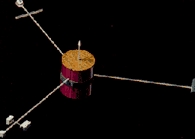Lunar Prospector
Part of the Discovery program
 Lunar Prospector is the third of NASA's Discovery missions and will orbit the moon in June 1997. The mission is led by Lockheed and NASA's Ames Research Center and the entire cost, including launch vehicle, should be less than $63M ($59M in FY92 $). Lunar Prospector is designed to determine the origin, evolution, and current state of resources of the Moon via low-altitude mapping of its surface composition, magnetic fields, gravity fields, and gas release events. The mission will provide a new map that shows in unprecedented detail the chemical composition and the magnetic and gravity
fields of the Moon.
Lunar Prospector is the third of NASA's Discovery missions and will orbit the moon in June 1997. The mission is led by Lockheed and NASA's Ames Research Center and the entire cost, including launch vehicle, should be less than $63M ($59M in FY92 $). Lunar Prospector is designed to determine the origin, evolution, and current state of resources of the Moon via low-altitude mapping of its surface composition, magnetic fields, gravity fields, and gas release events. The mission will provide a new map that shows in unprecedented detail the chemical composition and the magnetic and gravity
fields of the Moon.
Spacecraft
The spacecraft bus is a 126 kg graphite-epoxy drum with three deployed booms carrying instruments. Spin stabilization is used with Sun and limb sensors for attitude determination. Hydrazine propulsion system with six 22-N thrusters provide 1430 m/s of delta-V. Body mounted solar cells provide 206
W. 15 AHr CPV NiH2 batteries. Communications use two S-Band transponders with slotted, phased array medium gain antennas. The spacecraft has no on-board computer. Three 2.5 meter deployable booms for science instruments.
Payload
Gamma-ray and neutron spectrometers will provide information on the composition of the Moon's crust. A magnetometer and electron reflectometer will map the lunar magnetic field. An alpha particle spectrometer will identify the location and type of gasses released from the lunar surface. Doppler
tracking in S-Band will provide gravity field measurements.
| Country of Origin | United States |
| Customer/User | NASA |
| Manufacturer(s) | Lockheed |
| Size | 1.22 m tall, 1.4 m diameter (excluding booms) |
| Launch | Planned for June 1997 using LLV2 |
| Orbit | 100 km lunar orbit, period of 118 min. |
| Design Life | One year in lunar orbit |
Information in The Mission and Spacecraft Library is provided without warranty or guarantee. USE AT YOUR OWN RISK.